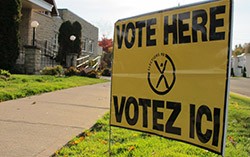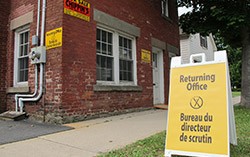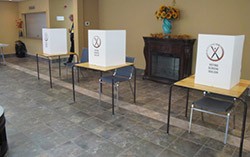Elections New Brunswick offers a variety of voting options to electors to make voting both convenient and accessible. During an election, we will send you a voter information card that tells you your advance and Election Day polling stations, and also indicates your local Returning Office contact information.
How to Vote
Here are the many different ways of voting

If you are an eligible elector in New Brunswick, you have several options to cast your vote:
In Person at Election Day
You may choose to vote in person at your designated polling station on Election Day, between 10 a.m. and 8 p.m. Check your Voter Information Card or the “Where do I Vote” pages of this website to determine your polling station.
In Person on Advance Poll
You may choose to vote in person at your designated advance polling station on the designated Advance Polling Day(s), between 10 a.m. and 8 p.m. Check your Voter Information Card or the “Where do I Vote” pages of this website to determine your polling station.

In Person at a Returning Office
Provincial Elections:
Immediately after a provincial election is called, you may obtain a blank “write-in” ballot. To vote, you must write the name of the candidate who you wish to vote for. Once nominations close, regular ballots are printed for the election, at which time you can then mark your choice normally.
Local Government, Rural Districts, District Education Council, or Regional Health Authority Elections and Plebiscites:
Approximately one week after nominations close, regular ballots are printed for the election. Once they are ready, you may choose to vote in person directly at any returning office in the province
Regardless of the type of election, if you visit a returning office outside of your local area, the staff will be able to provide you with a ballot for the election contests where you ordinarily reside.
Electors with disabilities may choose to vote in person at a returning office, using an Audio Ballot, where the choices are read to you by the tabulation machine. You can use a Braille controller, sip and puff device or paddles to make your selection, and a printer will print out your marked ballot which is then counted with all of the other ballots cast in the office.
Regardless of how they were cast, all ballots are counted locally in the office tabulation machine and votes are compiled across the province on election night.
By Mail
If you are unable to vote in person at any of the options above, or are travelling abroad, you can choose to vote by mail using a Special Ballot. To vote by mail, you must complete an Application for a Special Ballot.
There are 5 easy steps to follow in order to receive your Special ballot and vote by mail:
1. Complete the appropriate Application for a Special Ballot for the type of election underway. Downloadable forms for each type of election can be found on the Forms page.
2. As soon as the election begins, you can send your Application for a Special Ballot to your local returning office by:
a. Fax; or
b. Scanning (or high resolution) and email.
3. If your name is not on the List of Electors, the Special Voting Officers from the returning office will contact you. If this occurs, you will also need to complete a signed certification that you meet the qualifications to vote, and provide a photocopy or scan of one or more pieces of ID that between them show your name, address and signature (i.e. copy both sides of your driver’s license).
4. Once your application is approved and ballots are able to be sent, the Special Voting Officers from the returning office will prepare a Special Ballot Mail-In Voting Kit, and send it to your temporary address by courier. The kit includes your ballot, a secrecy envelope, a return envelope and detailed voting instructions.
5. Once you receive your Special Ballot Mail-In Voting Kit, mark the ballot and follow the instructions on how to send the sealed envelopes back. You are responsible for any costs to return your ballot to the local returning office, using your choice of mail or courier.
In order for you ballot to be counted, it must arrive at the local returning office no later than 8 p.m. on Election Day. Any ballots that arrive after the close of poll will not be counted.
In Person at Home
Electors who will be unable to attend the ordinary or advance polls due to the illness or incapacity of the elector, or due to the illness or incapacity of a person for whose care the elector is primarily responsible, may contact their returning office and request that special voting officers visit their home. Please note that such visits must be scheduled in advance. While we make every effort to assist each elector in this situation, it may be impossible to arrange for a visit on short notice or where the number of appointments is already at the day’s maximum.
In Person at a Nursing Home or Special Care Home
Electors who are living at a nursing home, special care home, or other treatment centre have may choose to vote using any option above or an Additional Poll may be arranged at the treatment centre by the returning officer and facility administrator. More information on this process is available by following the appropriate link.
How to mark your ballot
TopTo vote on your ballot, simply fill in or make an “X”
or make an “X”  in the circle located to the right side of the candidates’ name.
in the circle located to the right side of the candidates’ name.

Provincial Elections
In Provincial elections, you vote for a maximum of one candidate in your electoral district.
Local Government, Rural Districts, District Education Council, or Regional Health Authority Elections and Plebiscites
In Local Government, Rural Districts, District Education Council, or Regional Health Authority Elections and Plebiscites, you will receive a ballot with more than one contest printed on it. For example, you may receive a ballot that includes a contest for Mayor, a contest for Councillor, and a contest for District Education Council. In by-elections, where only one position is being filled, you may receive a ballot with only one contest.
The number of allowable votes per contest is always listed under the title of the contest. (Eg. Councillor At Large: Vote for not more than 4).
Example ballots for each type of election can be viewed on the Forms page.
If you need help to mark your ballot
TopSome electors need help to mark their ballot. You can have a friend or an election officer assist you in marking the ballot, or use one of the assistive devices Elections New Brunswick provides.
For more information, follow the FAQs link, and click on “Accessibility and Accommodation”.
If you are not on the voters list
TopYou must be on the Voters List in order to vote in an election. To be added, you meet the qualifications to vote, and complete a signed certification that you meet the qualifications to vote, and show one or more pieces of ID that between them show your name, address and signature.
Follow the link “Voters List” for details of how to get on the List of Electors for an election.

